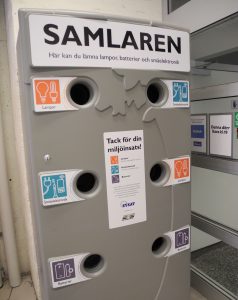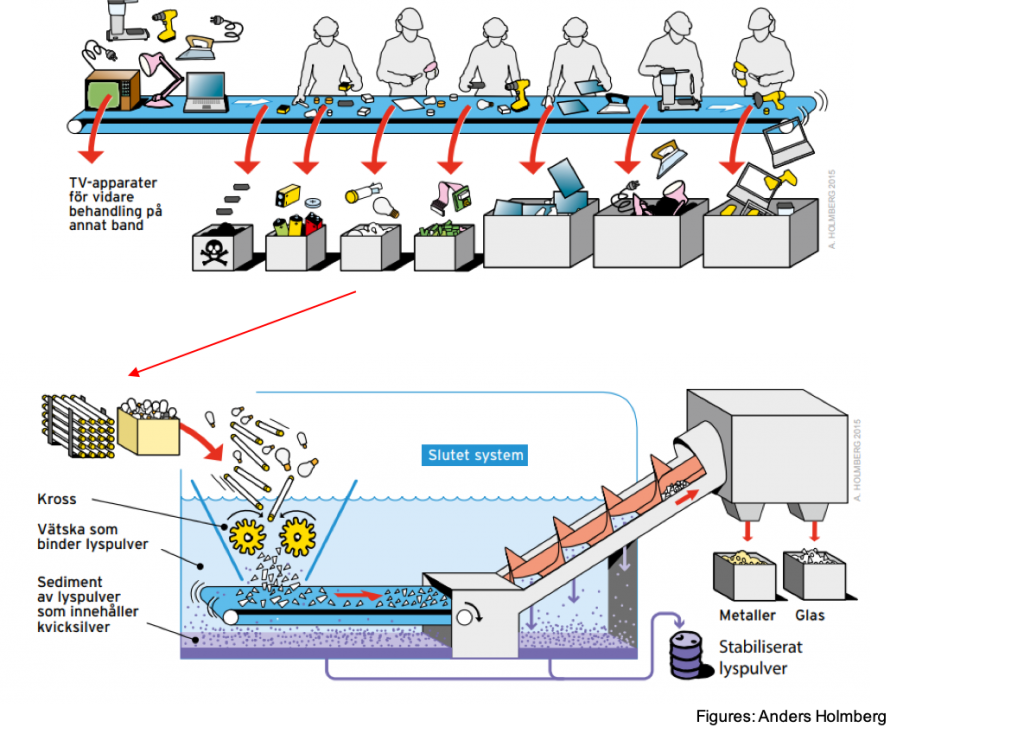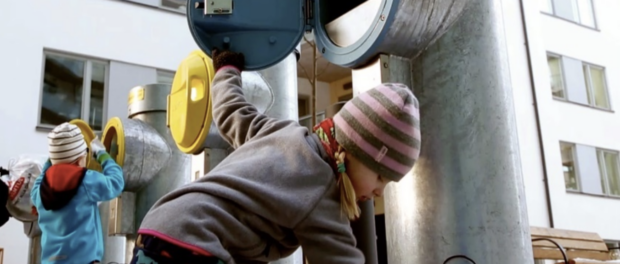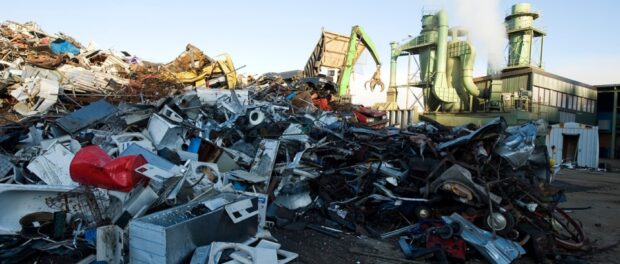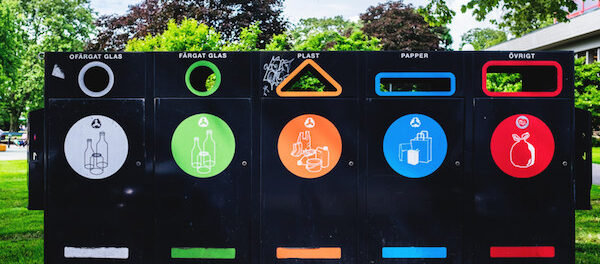
On June 7, Carlos André do Nascimento, director of the National Organized Graffiti Workshop Space (RONGO)—a community-based arts and environmental initiative and member of Rio de Janeiro’s Sustainable Favela Network—invited Catalytic Communities* collaborator and Lund University student researcher Emma Bergman to deliver a presentation on Sweden’s waste management system at the organization’s headquarters in Pavuna, located in Rio’s North Zone. Bergman’s presentation at RONGO is an example of the Sustainable Favela Network’s knowledge exchanges supporting the development of sustainable solutions from Rio’s favelas. Below, Bergman explains the ins and outs of Swedish sustainability practices.
The Fundamentals of Sweden’s Waste Management System
 Sweden has one of the highest recycling rates in the world: in 2017, 99.5% of household waste was diverted from sanitary landfills and recycled in one way or another. This is made possible through the efforts of the Swedish government, municipalities, trade associations, private companies, and a dedicated population.
Sweden has one of the highest recycling rates in the world: in 2017, 99.5% of household waste was diverted from sanitary landfills and recycled in one way or another. This is made possible through the efforts of the Swedish government, municipalities, trade associations, private companies, and a dedicated population.
Laws regulating Sweden’s waste management system can be found in the Swedish Environmental Code. According to Chapter 15, which provides the system’s foundation by defining and regulating all parts and actors in the system, a “waste holder” is defined as anyone who has in their possession a product or material that they discard, intend to discard, or are obligated to discard. This means that waste holders can be individuals, restaurants, schools, or even commercial businesses. This article aims to explain some of the code’s most important laws on solid waste and how they are interpreted and put in practice.
One of the Swedish recycling system’s major assets (and a reason for the country’s high recycling rate) is the population’s environmental consciousness: individuals are used to the idea of separating waste materials generated by their households. While the law only stipulates that the waste holder is responsible for ensuring that the waste is handled in an acceptable manner with regard to human health and the environment, many Swedes go further.
The Waste Hierarchy
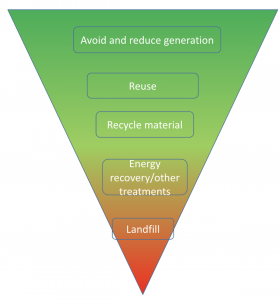
Swedish and European Union legislation establish what is known as the “waste hierarchy,” a set of waste management priorities ranking potential disposal choices in terms of sustainability. The following list, ranked from most to least sustainable option, serves as a guideline to prevent resource depletion and should be considered in order:
- Avoid and reduce the generation of waste
- Reuse products and materials as much as possible in their current form
- Recycle materials into new products
- Recover energy from the material
- Dispose of waste in a landfill
Anyone who collects, transports, recycles, disposes of, or treats waste must apply and act according to this list.
Another important factor contributing to Sweden’s high recycling rate is its highly functional collection system, which is based on a law dictating producer responsibility. The 1994 ordinance states that anyone who manufactures, transfers or imports a certain type of product must ensure that this product—after being discarded—is collected, transported away, recycled, or disposed of in a healthy and environmentally acceptable manner. The law applies to eight types of materials or product categories: cars (under three tons), car tires, pharmaceuticals, packaging materials, electronics, electric equipment, batteries, and paper (newspapers, magazines and other similar paper products). Even within this group, “packaging materials” includes everything from plastic to colored and non-colored glass, cardboard, and metals such as aluminum, steel, and copper.
As a consequence of this law, producers of similar products typically join forces and create trade associations for the purpose of facilitating collection and recycling. One such association, the Packaging and Newspaper Collection Association, is responsible for the collection of all waste of this kind generated in Sweden. Another large association is the Electric Circuit Association, which handles electric and electronic equipment waste (WEEE).
The collection system for WEEE, which includes some hazardous waste such as strip lights and batteries, is slightly different than that for packaging. Since 2007, many supermarkets have introduced a collection container called “the Collector” located nearby or inside the store to facilitate the proper disposal of smaller devices. Other collection points for these types of materials are called waste and recycling stations (WRS). Managed by municipal waste management companies, these stations provide containers for separation and collection of all types of household waste, including hazardous waste, yard waste, renovation materials, furniture, metal, cardboard, car parts, and textiles.
Lessons for Rio: Electric and electronic waste contains many valuable metals that can de sold to generate income. This market is not extensively explored in Rio or Brazil, and presents significant opportunities for local collection and recycling. It should be noted, however, that electric and electronic waste needs proper handling under controlled conditions, as some products also contain hazardous compounds.
Following WEEE collection, whether at the supermarket or at a WRS, waste is transported to specific recycling facilities where it is further separated and treated. One of the first steps in this process remains completely manual to this day, as there is still no technology capable of replacing people’s ability to carefully identify and gently separate different products. Following manual separation, many of the product components are recycled through an automated process, resulting in fine end products that can be introduced as raw materials into other production processes.
In addition to laws concerning producer responsibility, the environmental code stipulates that due to the high environmental value of certain materials, package producers for consumption-ready drink containers such as polyethylene terephthalate (PET) bottles and aluminum cans are obligated to design and implement a collection system involving premium payments. This premium, in turn, encourages consumers to return the packaging to the system. A separate collection system has now been implemented in connection with supermarkets, making it easy and profitable for customers to return packaging. Through an agreement with supermarkets, the trading company for these products, Pantamera, charges customers approximately US$0.11 extra for small PET bottles and aluminum cans and US$0.22 extra for large PET bottles. This value is reimbursed to the customer as a gift voucher at the affiliated supermarket when they return the empty packaging to the system.
Lessons for Rio: Unfortunately, the material collected, separated, and sold by informal waste collectors and cooperatives goes undervalued in Rio de Janeiro. The true value of the environmental and market services these workers provide is greater than what they are paid today. Low quality material that demands many hours of work for little payment could instead be reused to return value to households in the community. Transforming low quality materials into jewelry or other sellable goods, for example, could potentially increase returns on waste that would otherwise receive little payment in exchange. Materials like TetraPak packaging can also be used as reflective siding to keep homes cool.
National recycling targets for packaging materials and papers are decided by the Swedish government. According to trading companies, in 2017, 70% of glass; 65% of cardboard, paper board and corrugated board; 70% of metals; 30% of plastics; 75% of newspapers and paper; 90% of PET bottles; and 90% of aluminum cans were recycled. As Sweden has a long tradition of recycling paper and glass, these are the two materials with the highest recycling rate, at 95.5% and 93% respectively. Around 81.3% of metal packaging, 81.3% of cardboard, and 80.2% of plastic packaging was recycled. Despite the separate system for PET and aluminum collection, PET recycling only reached 83.3 % and aluminum 85.9%, meaning that these two categories were the only ones that failed to meet national targets in 2017.
For all waste that does not fall into any of the producer responsibility categories (such as residual waste, yard waste, furniture or smaller car parts), the municipal government is responsible for collection and treatment. This has resulted in various models and experiments to find suitable systems for each municipality. However, most of the different collection systems in Sweden are integrated, meaning that one collection point has containers for most types of materials and waste, whether it falls under the responsibility of the producer or the municipality. The idea behind this is to facilitate proper waste disposal in order to increase the recycling rate. The collection point for packaging, residual waste, and smaller items is normally located near residential properties, a so-called “property-close collection point.” For larger waste items such as furniture, yard waste, and car parts, the waste holder is obligated to go to a WRS. In an attempt to increase the recycling rate, in 2018, the Swedish government decided that property-close collection should be connected to no less than 60% of all properties in Sweden by 2021 and that the complete financing of this initiative lies with producers.
It is also the responsibility of the municipalities to collect and treat food waste. As Swedish law does not require that food waste be separated from other types of waste, only 223 of 290 municipalities provide separate containers for food waste as of today. However, in 2018, the national government opted to oblige municipalities to offer and finance this service to all households starting in 2021. Most of the collected food waste in Sweden is treated through anaerobic digestion to produce biogas, though some of it is composted into soil. In 2017, the total energy production from Swedish food waste was 975,680 MWh, of which 856,170 MWh was biogas suited for vehicles. This replaced around 83.3 million cubic meters of natural gas which, when combusted, is equivalent to approximately 42,000 tons of CO2.
Lessons for Rio: Though the ideal protocol for handling food waste remains anaerobic digestion with the production of biogas and recycling of nutrients, currently taking place in one favela community in Rio, communities in Rio and around Brazil can improve their environment simply by separating food scraps (particularly vegetable matter) from the rest of household waste through simple composting at home. This way, families can both decrease health risks and recycle nutrients back into the community, all the while reducing their environmental impact. Composting food waste at home helps reduce emissions and return nutrients to local soil. Remember not all food waste is appropriate for composting, read more about the do’s and don’ts here.
Importing Waste
Located in the far north of Europe, Sweden’s climate is cold and dark for the majority of the year. As a result, the nation has a need for a high-functioning and efficient heating and electric system and, for this reason, residual waste is used as fuel for incinerators producing heat and electricity. In 2017, energy recovery through waste incineration in Sweden was equivalent to the heat demand of 1,250,000 apartments and the electricity demand of 680,000 apartments. This also minimized the amount of waste being disposed of at landfills, and greenhouse gas emissions from landfills have been reduced by more than 76% since 1990 as a result. Furthermore, waste incineration replaces the need for fossil fuels and thereby avoids further emissions.
According to the Swedish Waste Management Association, the capacity of incineration plants is approximately 21% larger than the supply of residual waste that is generated in Sweden today. As such, there is a demand for more residual waste as fuel and the solution is to import waste from other countries. According to the Swedish Environmental Protection Agency, more than 2.5 million tons of waste is imported to Sweden each year, mostly from Norway and the UK.
In the past six years, some 50% of all household waste has been treated through energy recovery. Around 15% is recycled organic waste, 34% materials recycling, and less then 0.5% goes to sanitary landfills.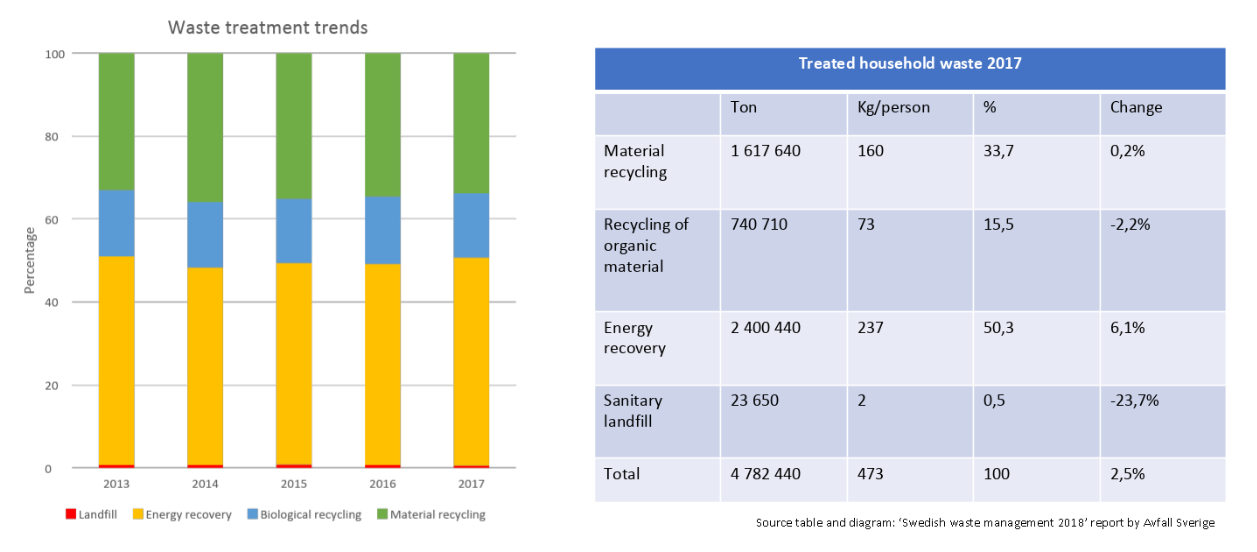
The Swedish waste management system is successful because of its ambitious environmental policies, general respect for Swedish law, and a population with a history of appreciation and respect for nature. The new regulations being implemented in the next two to three years will likely continue to improve recycling rates and further reduce the environmental effects of generating waste.
Check out Bergman’s full presentation here:
Emma Bergman is pursuing a master’s degree in environmental engineering at Lund University’s Faculty of Engineering in Sweden. Her research looks at waste management in Rio’s favelas.
*Catalytic Communities is the organization that publishes RioOnWatch and coordinates the Sustainable Favela Network

